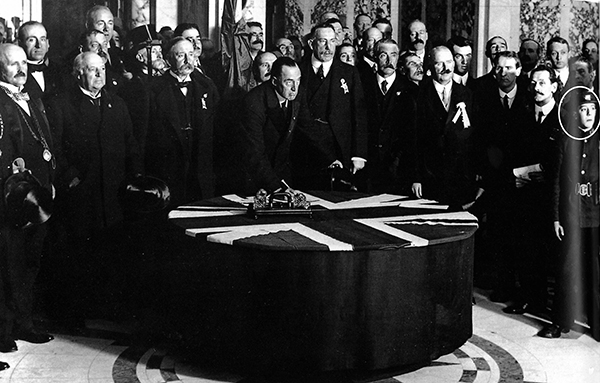Bite-sized History
Published in Issue 6 (November/December 2016), News, Volume 24BY TONY CANAVAN

Time lost
With all the attention on the centenaries of the Easter Rising and the Battle of the Somme, some other centenaries of Irish interest have been overlooked. For example, 100 years ago Ireland abandoned Dublin Mean Time and adopted Greenwich Mean Time. It seems that the British government decided to use the confusion caused by the 1916 Rising to introduce the Time (Ireland) Act to abolish Dublin Mean Time, which was 25 minutes behind Greenwich Mean Time, bringing Ireland into line with the rest of the United Kingdom. The measure was opposed by Irish nationalists and farmers but generally welcomed elsewhere in civic society.
The Fitzwilliam Museum
This year also marks the second centenary of the founding of the Fitzwilliam Museum in Cambridge, described by the Standing Commission on Museums and Galleries in 1968 as ‘one of the greatest art collections of the nation and a monument of the first importance’. It owes its foundation to Richard, seventh Viscount Fitzwilliam of Merrion, who in 1816 bequeathed to the University of Cambridge his works of art and library, together with funds to house them, to further ‘the Increase of Learning and other great Objects of that Noble Foundation’.
Born in Richmond, Surrey, in 1745, Richard Fitzwilliam was educated at Trinity College, Cambridge. During his travels he built up an impressive collection of illuminated manuscripts, paintings, prints and drawings. He succeeded his father, also Richard, to his Irish title and estates as Viscount Fitzwilliam of Merrion in County Dublin, with the family seat at Mount Merrion House. During his time as viscount, Fitzwilliam commissioned the development of part of south Dublin. His developments included an Act to enclose Merrion Square in 1791, the design of Fitzwilliam Square in 1789 and an Act to enclose it in 1813. He also commissioned a new church for Booterstown in 1812, called the Church of the Assumption.
Lost summer
This is also the bicentenary of the ‘year of no summer’. In 1816 the weather in Europe and North America resulted in widespread crop failures and even famine. Spring arrived but then low temperatures returned, as the sky seemed permanently overcast. The lack of sunlight became so severe that farmers lost their crops and food shortages were reported in Ireland, France, Britain and the United States. It is said that the gloomy weather helped inspire the writing of Mary Shelley’s classic horror tale, Frankenstein. It would be more than a century before anyone understood that the eruption of an enormous volcano, Mount Tambora, on the remote island of Sumbawa in the Indian Ocean, a year earlier had thrown enormous amounts of volcanic ash into the upper atmosphere, blocking out the sunlight.
Legendary telegram boy
In the famous photograph (above) of Edward Carson in Belfast City Hall leading the signing of the Ulster Solemn League and Covenant in 1912, there is a telegram boy on the extreme right, who was delivering messages of support from throughout the British Empire. For over a century his identity was unknown until it was discovered that he was Dennis Hanna (then aged fifteen), a Catholic from Belfast’s Short Strand. Recent research has revealed that on the outbreak of the First World War Hanna joined the Royal Irish Rifles and that he was killed on 18 August 1916. He is buried in Vermelles British cemetery in the French department of Pas-de-Calais.
Sewage gate
On the 50th anniversary of the blowing up of Nelson’s Pillar in Dublin, it has emerged that the original gates to the entrance of the stairs inside the pillar have been languishing ever since in the Ringsend sewage pumping station. Backed by popular historian Donal Fallon, Labour Senator Kevin Humphries has called for the gates to be put on display in O’Connell Street. It has been suggested that a place might be found in the GPO’s lavish permanent 1916 exhibition.
‘Dem bones, dem bones’
Ironically, while digging a service trench for the construction of Kilkenny’s St Mary’s Medieval Museum, workers unearthed four medieval skeletons. Archaeologists who have examined the find say that they are female and date from between 1250 and 1350, probably among the first Normans to settle in the city. The youngest belongs to a girl aged eight and the oldest to a woman of twenty. The skeletons show signs of hardship and heavy labour and were buried in the south-west corner of St Mary’s graveyard, which was set aside for the poor of the town. Following research and analysis, they are likely to be reburied in St Mary’s.
Letting down the drawbridge
Enniskillen Castle, one of the major attractions in the County Fermanagh town, has reopened to the public following a £3.5m refurbishment that began in 2015. The castle houses the county museum, which now has seven new galleries telling the county’s story from prehistoric times and taking in the recent excavations at Drumclay Crannog. Archaeologists found over 5,500 artefacts in the 1,000-year-old island dwelling. Visitors will also get the chance to see the behind-the-scenes work of the museum, where restoration and care of artefacts take place. A new information centre on the area has also been added to the museum.
















